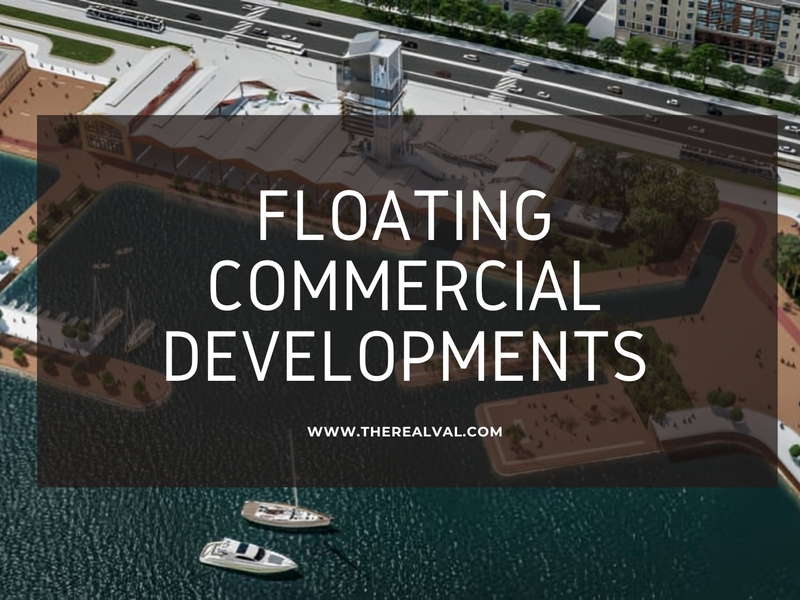As climate change accelerates and urban populations soar, coastal cities are grappling with rising sea levels, land shortages, and housing crises. Floating commercial developments are emerging as a ground-breaking solution, which is offering sustainable, adaptable, and resilient alternatives to traditional real estate. Let us explore how waterborne real estate can tackle these pressing challenges while supporting global sustainability goals.
Why Floating Developments Are the Future
- Rising Sea Levels Demand Innovation: By 2100, sea levels could rise by up to two meters, endangering over 500 coastal cities and displacing millions worldwide. Floating developments offer a proactive solution, creating flood-proof infrastructure that adapts to changing water levels.
- Urbanization Is Shrinking Available Land: With 60% of the world's population expected to live in cities by 2030, land scarcity is a growing concern. Floating structures unlock new urban spaces without encroaching on already limited land resources.
- Climate Resilience Is Non-Negotiable: Unlike traditional buildings, floating developments are buoyant and naturally adapt to fluctuating water levels, making them an ideal choice for disaster-prone areas.
The Advantages of Floating Commercial Developments
- Sustainability: A Green Future on Water
- Floating cities integrate renewable energy sources like solar panels and wind turbines, reducing carbon footprints.
- They support circular economies by converting waste into energy and compost while revitalizing marine ecosystems.
- Water-efficient designs minimize freshwater consumption, aligning with eco-friendly real estate principles.
- Modularity & Scalability: Built for Adaptability
- Modular structures enable flexible expansion based on population growth or seasonal demands.
- These developments can be relocated or reconfigured, providing unmatched versatility in urban planning.
- Economic Growth & Business Potential
- Floating commercial hubs attract tourism and unlock new business opportunities in coastal regions.
- They help address housing shortages while maintaining affordability through sustainable resource management.
Technological Innovations Powering Floating Developments
- Advanced Materials: Cutting-edge materials like Biorock create durable artificial reefs that enhance marine biodiversity while ensuring structural stability.
- Smart Energy & Waste Management: Zero-waste systems convert food waste into energy and use algae ponds for natural sewage treatment. Additionally, floating cities run on renewable energy, reducing dependence on external power grids.
- Hydrodynamic Engineering: Floating platforms are designed to resist wave forces and extreme weather, ensuring long-term durability and safety.
Challenges and Considerations
- Regulatory Hurdles
- Governments need to establish clear legal frameworks for jurisdiction, ownership, and environmental compliance.
- Zoning laws and maritime regulations must evolve to support large-scale floating infrastructure.
- High Initial Costs
- The upfront investment in floating real estate is significant, making large-scale projects financially challenging.
- Developing nations may struggle to implement these solutions without public-private partnerships or innovative financing models.
- Public Perception
- Floating cities are often seen as futuristic or exclusive rather than practical, scalable solutions.
- Raising awareness and demonstrating real-world success stories will be key to shifting public and investor confidence.
Regulatory Frameworks and Challenges
- Maritime vs. Real Estate Law- Many governments struggle to classify floating structures, leading to regulatory uncertainty that complicates financing, insurance, and long-term ownership.
- Territorial Waters Governance- Floating developments within 12 nautical miles of shore typically fall under national jurisdiction but often involve multiple regulatory agencies with overlapping authority.
- Environmental Impact Assessment- Stricter regulations are emerging to protect marine ecosystems, but global standards remain inconsistent, making compliance challenging for developers.
Emerging Best Practices: Pioneering Regulatory Models
Forward-thinking coastal cities are creating specialized frameworks to facilitate floating developments while ensuring sustainability and accessibility.
- The Netherlands’ Water Act- Establishes clear permitting pathways for floating structures while prioritizing environmental sustainability and public access.
- Seattle’s Floating Structure Guidelines- Introduces detailed zoning and technical regulations specifically designed for floating commercial spaces.
- Copenhagen’s Blue Framework- Seamlessly integrates floating developments into urban planning, streamlining approval processes for innovation-driven projects.
Floating commercial developments are more than just an innovative concept- they represent a transformative approach to tackling climate change, population growth, and economic expansion in coastal cities. While technical, regulatory, and financial hurdles remain, successful projects worldwide prove their feasibility and long-term benefits.
For developers, investors, and city planners, waterborne real estate presents a unique opportunity to build resilient, high-value assets that address pressing urban challenges. With their adaptability and distinctive appeal, floating developments have the potential to deliver superior returns while shaping the future of sustainable urban living.
Trending





